Hands-free Car Mic Module Design
A hands-free communication system for cars has been developed to avoid the danger of drivers having to hold the phone while driving. Drivers can speak to the microphone module directly. It can be divided two categories: front-mounted and after-mounted markets. The front-mounted microphone module is mainly installed in the roof map lights; the speaker is the existing speaker system in the car; the after-mounted type is commonly clipped to the sun visor or fixed behind the steering wheel. Most of the products are equipped with speakers; both kinds of AEC functions are required to avoid excessive echo during a call in the car, which will affect the quality of the call. The microphone module for the vehicle is shown in Fig.4.1

The microphone is usually an ECM or MEMS microphone for the front-end receiving function. There are two microphone output interfaces, digital and analog (Fig.4.2), and directivity can be divided omnidirectional and unidirectional (Fig.4.3).


The advantage of the digital type is it has better anti-noise, but the distance to the Audio Codec can't be too far. However, if the analog type is used with noise-isolated or twisted wires, the transmission distance can usually be more than 2M. Regarding directivity, a single-pointing microphone can independently attenuate noise in a 180-degree direction, such as the engine noise, while a pieces array microphone can further only receive the voice in the driving area to make the sound quality better, but it has to be with beamforming calculations Law & DSP. (E.g., Fig.4.4)


 RFQ
RFQ